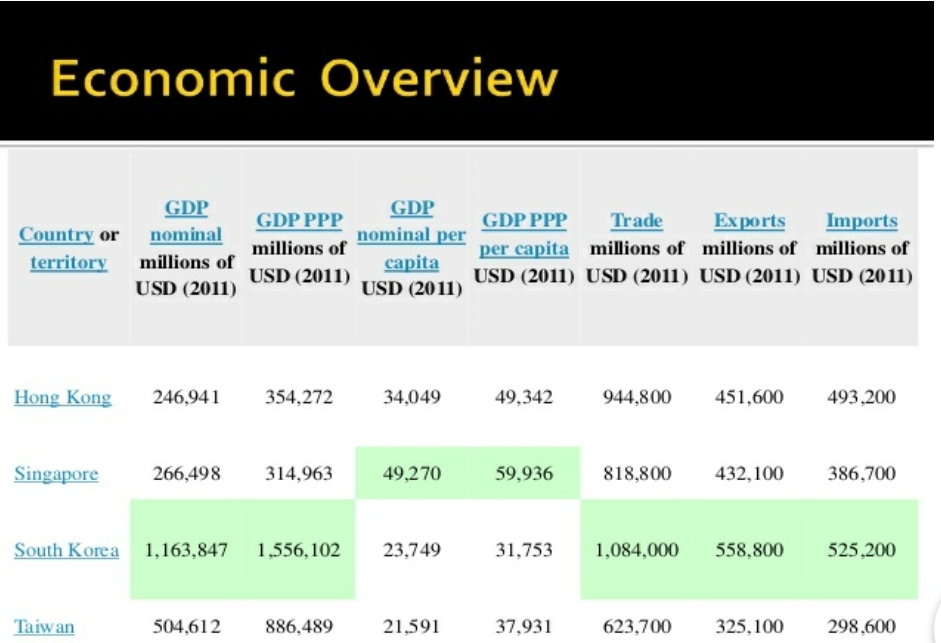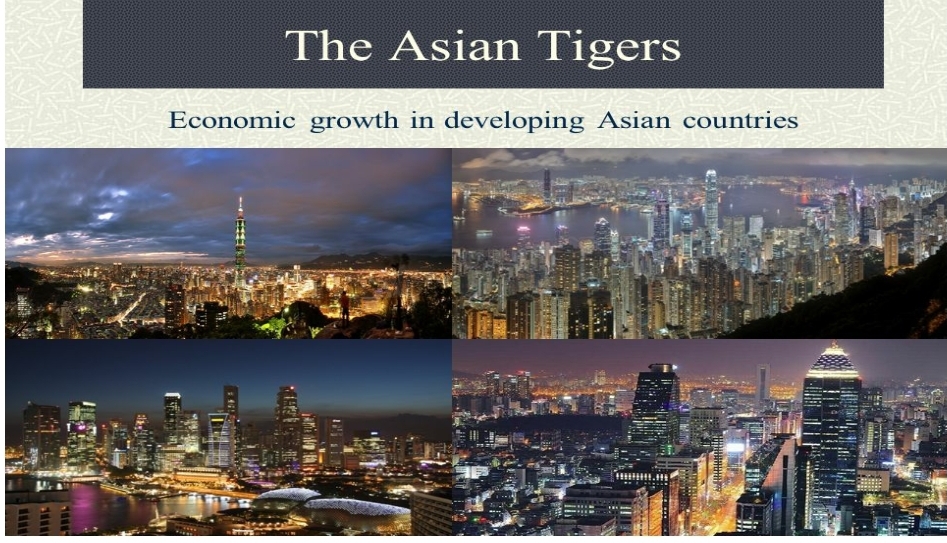The Four Asian Dragons, who go by multiple names such as Four Asian Tigers or Four Little Dragons, are the economies of Hong Kong, Singapore, South Korea and Taiwan. The economies of the said four countries experienced rapid industrialization and maintained exceptionally high growth rates (exceeding 7% a year) between the period of the mid 1950s/early 1960s and the 1990s. By the early 21st century, all of the four countries had developed into high-income economies who specialized in areas of competitive advantage.
Hong Kong and Singapore have emerged as supreme world-dominating international financial centres, whereas South Korea and Taiwan are world kingpins in the manufacturing and processing of electronic components and devices. The stories of economic success of these four countries have served as role models for numerous developing countries, especially for the Tiger Cub Economies of South-East Asia.
A contentious World Bank report, “The East Asian Miracle 1993” credited neoliberal policies with the responsibility for the boom, including the maintenance of export-oriented policies, low taxes and minimal welfare states. Institutional analysis also states that some state intervention was involved. However, others argued that industrial policy and state intervention had a much greater impact than is portrayed by the World Bank report.
Charged by rapid-industrialization and exports, the four Asian Tigers have consistently sustained high-growth economic rates since the 1960s. All of this has facilitated these economies to be in line with the world’s wealthiest nations.
The world economy had begun to make headway during the early 1950s after the Second World War and the Korean War in the early 1950s. Considerable leaps in air telecommunications and the aviation industry coupled with probable world peace specified that the countries of the world were opening up their borders, and the Four Tigers, took complete advantage of this aperture. All the four countries had workable trade economies, established ports, highly literate populace and advanced infrastructure left behind by their then foreign conquerors. The Asian Tigers capitalized on this situation immensely to elevate themselves from poverty in the 1960s; these countries had plenty of inexpensive labour. Combined with educational restructuring, they were smart to leverage this amalgamation into a low-priced, yet industrious labour force. The four countries devoted themselves to social equality in terms of land reforms, promotion of property rights and the welfare of agricultural workers. In no time, products and services from these nations were in high demand.

Hong Kong, in 1891, had already begun a booming stock exchange, thus shifting from the export markets to financial services was a reasonable decision for the country. Immediately followed by Singapore, the two small nations are presently cardinal global financial centres. During that interval, South Korea and Taiwan were propelling the 1980’s -1990’s tech boom, nowadays Taipei and Seoul are leaders in cutting-edge technology and also home to the biggest names in electronics. This evolution occurred so expeditiously; hence the sobriquet: ‘The Asian Miracle’.
The economic growth of the Four Asian nations enabled them to sail through the local 1997 Asian Financial Crisis and also 2008 World Economic Crisis. At present these four nations significantly get enlisted in the International Monetary Fund’s global list of top 40 advanced economies.
As per 2018, the amalgamated economy of the Four Asian Tigers accorded to 3.46% of the world’s economy, with a total Gross Domestic Product (GDP) of 2,932 billion US dollars. The GDPs of Hong Kong, Singapore, South Korea and Taiwan were worth 363.03 billion, 361.1 billion, 1,619.42 billion and 589.39 billion US dollars respectively in 2018. These figures represented 0.428%, 0.426%, 1.911% and 0.696% of the global economy. Their combined economy surpassed the GDP of the United Kingdom in the mid-2010s.

The four Asian dragons—Hong Kong, Singapore, South Korea and Taiwan—once fascinated the economic world. Starting from the early 1960s, until the 1990s, they methodically attained double-digit growth. A generation that had toiled as farmers and labourers watched their grandchildren become some of the most educated people on the planet. The tigers started off by designing cotton tunics, plastic flowers and black wigs. Before long, they were producing memory chips, laptops and equity derivatives. In the process, they also precipitated an exuberant academic discourse about the origin of their victory. Some attributed it to the anvil of government direction; others to the furnace of competitive markets.
Then the world turned away. The Asian financial crisis demolished their mystique. China was acknowledged as the new celebrity as development. The tigers themselves seemed to lose their stride. The Four Tigers must now move from growth-oriented developmental states, to growth-friendly welfare states.
By Yashasvi Kanodia
Literary Sources:
- Four Asian Tigers: Who Are The 4 Asian Tiger Economies?, Science ABC. (2020) https://www.scienceabc.com/social-science/asian-tiger-economies.html.
- After half a century of success, the Asian tigers must reinvent themselves, The Economist. (2020) https://www.economist.com/
Image Sources:
- Four Asian Tigers, Wikipedia https://en.wikipedia.org/wiki/Four_Asian_Tigers
- Sunil Chichra, Asian Tigers, LinkedIn https://www.slideshare.net/SunilChichra/asian-tigers-41440378
- Economic growth in developing Asian countries, SlidePlayer, https://slideplayer.com/slide/4367580/
